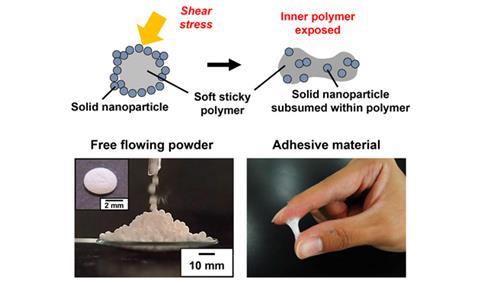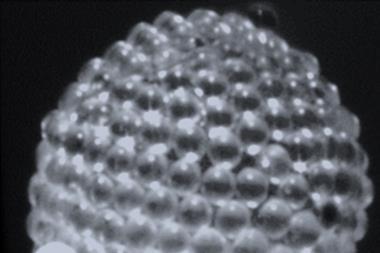Researchers strive to make glue that you can handle
Scientists in Japan have developed an adhesive that starts out as powder but transforms into glue for hard-to-reach places when pressed. This represents a promising application for liquid marble technology.
Liquid marbles are millimetre-sized liquid droplets that when coated in a hydrophobic powder, lose their wetness. Pressure-sensitive adhesives (PSAs) are viscoelastic polymers that instantly stick to solid surfaces through van der Waals forces. They are used in tapes, labels, post-it notes, spray droplets and adhesives, but PSAs’ sticky nature can make them difficult to handle. Combining these two technologies, Syuji Fujii and his team at the Osaka Institute of Technology in Japan and co-workers at the Max-Planck Institute for Polymer Research in Germany have developed liquid marbles made up of soft poly(n-butyl acrylate) latex polymer particles that form a tacky polymer core coated with a hard hydrophobic calcium carbonate nanoparticle shell. Initially, the marbles show no adhesive properties but by applying shear stress – light contact pressure between finger and thumb for 1–30 seconds – the powder’s nanoparticle layers rupture, allowing the soft inner polymer to ooze out, endowing the material with adhesive properties.
‘Adhesion has been a crucial technology throughout all the ages and lands,’ reflects Fujii. ‘Whether building the Tower of Babel or fabricating smartphones, adhesion technology is absolutely essential. Technologies may come and go but adhesion is unaffected by changes in fashion.’

Because the PSA powder can be poured into confined and intricate spaces and activated by pressure, this removes the awkwardness of application facing other PSAs. ‘To satisfy desired design properties in the automobile, aerospace and electronics industries, there is a great need to stick together parts with complicated shapes,’ says Fujii. ‘We believe that our powder can stick these parts, which cannot be bonded using PSA tapes and spray droplets.’
‘Some aphids dispose of honey dew – a sticky waste liquid in which they could potentially drown – by encapsulating it in a hydrophobic powder to create a soft ball that can be rolled away,’ comments Glen McHale, an expert in applied and materials physics at the University of Northumbria in the UK. ‘Here, this is used as inspiration to encapsulate a sticky, hard-to-handle and transport, pressure-sensitive adhesive into a free-rolling and non-sticky liquid marble – a fantastic biomimetic idea.’
References
This article is free to access until 30 November 2015
S Fujii et al, Mater. Horiz., 2015, DOI: 10.1039/c5mh00203f












No comments yet